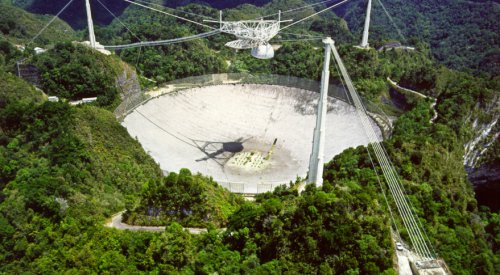The National Science Foundation has issued a call for proposals for partnerships to shoulder the cost of running the Arecibo radio telescope in Puerto Rico.
NSF is seeking proposals for cooperative partnerships to handle operations of the giant radio observatory starting in 2018.
NSF, which currently spends about $8 million a year running Arecibo, wants to cut its share of costs down to $2 million, with the new partners making up the difference. Proposals are due to the NSF in late April. [AP]
More News
The Air Force is considering taking over a spare NOAA geostationary weather satellite to provide coverage of the Indian Ocean region. During a panel at the AMS meeting this week, Ralph Stoffler, director of weather for the U.S. Air Force, said the Air Force and NOAA signed an agreement last month that could allow the Air Force to take possession of the GOES-14 weather satellite, currently a spare, and move it to the Indian Ocean region. That would address a long-running problem the Air Force has had with getting good weather data from the region, as it currently relies on aging European weather satellites there. The Air Force would not pay for the satellite, but would be responsible for developing a downlink station in the region. [SpaceNews]
NOAA says its newest weather satellite, GOES-16, is doing well in initial tests.The agency released the first images from the spacecraft earlier this week, and in presentations at the AMS meeting officials said the spacecraft is operating well. All six instruments on the spacecraft have achieved “first light” and are going through a rigorous test program expected to last through May. NOAA will then decide whether to operate GOES-16 from its eastern or western orbital slots. [SpaceNews]
Several members of Congress have asked DARPA to reconsider a planned satellite servicing program. In two separate letters, four members of Congress said that DARPA’s Robotic Servicing of Geosynchronous Satellites (RSGS) program appears to be in conflict with national space policy by competing with private efforts to develop satellite servicing systems. One member, Rep. Duncan Hunter (R-Calif.), complained that RSGS also appeared to duplicate a NASA satellite servicing program, Restore-L, focused on satellite servicing in low Earth orbit. Orbital ATK, which is not participating in the RSGS program, is developing its own satellite servicing system through its Space Logistics LLC subsidiary. [SpaceNews]
An Indian navigation satellite has suffered a problem with its atomic clock similar to those experienced on Europe’s Galileo spacecraft. One of the seven satellites in the NAVIC system, which provides navigation services for India and the surrounding region, is not in service because of a problem with its atomic clock, according to A.S. Kiran Kumar, chairman of the Indian space agency ISRO. The atomic clock is from a Swiss company, Spectratime, that provided the atomic clocks on the Galileo spacecraft recently reported to be suffering problems. Kumar said ISRO is working to try to resolve the clock problem and return the spacecraft to service. [NDTV]
Boeing unveiled Wednesday the new pressure suits that astronauts flying on the CST-100 Starliner commercial crew spacecraft will wear. Boeing developed the bright blue suit with David Clark Co. to be a lighter, more comfortable version of the “pumpkin” pressure suits worn on shuttle missions. The suit’s advances include lightweight fabrics and a hoodie-like helmet that can be zipped into place. Those suits would be first used on a CST-100 test flight to the ISS scheduled for August 2018. [Florida Today]
NASA has resumed full-fledged vibration testing of the James Webb Space Telescope after an anomaly during a test last month. NASA said this week that an anomaly during a Dec. 3 test was created by “gapping,” or very small motions, in a launch restraint mechanism in the telescope. Inspections of the telescope found no evidence of damage, and vibration tests have since resumed. NASA emphasized that Webb remains on budget and on schedule for a launch in October 2018 despite the delay caused by the anomaly investigation. [Spaceflight Now]
India has successfully tested the improved upper stage of its GSLV rocket. The C-25 cryogenic upper stage performed a 50-second static fire test on Wednesday and performed as expected. The upper stage was developed for the Mark 3 version of the GSLV, giving the rocket additional performance. The first GSLV Mark 3 launch is expected in the coming months. [The Hindu]
Pluto’s largest moon, Charon, may have once had a form of plate tectonics. In a new paper, planetary scientists conclude that the moon once had an ocean of liquid water and, as it froze, the moon’s crust expanded and cracked. That would explain features like rifts valleys found on Earth, although scientists said they haven’t seen anything that would show plated colliding into each other and creating mountains, as happens on Earth. [Space.com]
Elon Musk’s tunnel-boring ambitions will start, modestly, at SpaceX. In a series of tweets this week, Musk said he was following through with plans to build tunnels to help relieve traffic, starting “across from my desk at SpaceX.” As it turns out, that initial tunnel will go only from the company’s headquarters building to a parking garage across the street. The company had been in discussions with local officials in Hawthorne, California, where the company is based, about building either a pedestrian bridge or tunnel, and recently started preparations on company property for a tunnel. Three company employees were injured crossing that street in a hit-and-run accident last month. [Daily Breeze]
- DARPA satellite-servicing project comes under congressional fire
- Yahsat’s Mahmood on Brazil, Africa, Facebook and future satellites
- Brazilian satellite manufacturer seeks new business as it completes its first satellite
- Ex-Im’s satellite-lending lapse didn’t stop Israel’s Spacecom from buying American
- How Trump Could Wage a War on Scientific Expertise
Share with your friends

(0) Comments
This article comments are currently no :(